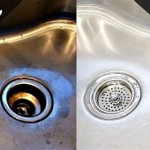The Sink In The Bathroom: A Comprehensive Overview
The bathroom sink, also often referred to as a washbasin, is a ubiquitous fixture in residential, commercial, and public restrooms. Its primary function is to provide a dedicated space for handwashing, facial cleansing, and other personal hygiene tasks. However, the sink's significance extends beyond mere functionality. It's a design element that contributes to the overall aesthetic of the bathroom, influencing its style, efficiency, and user experience. This article will explore the various aspects of the bathroom sink, encompassing its types, materials, installation considerations, and maintenance practices.
Types of Bathroom Sinks
Bathroom sinks are available in a wide array of styles, each designed to cater to specific space constraints, aesthetic preferences, and functional needs. Understanding the different types of sinks is crucial for making an informed decision during bathroom renovation or new construction projects.
1. Undermount Sinks: These sinks are installed beneath the countertop, creating a seamless and clean look. The rim of the sink is mounted to the underside of the countertop, leaving a smooth, continuous surface. Undermount sinks are particularly well-suited for bathrooms with solid-surface countertops like granite, quartz, or marble, as they showcase the countertop material. They are easy to clean, as there is no exposed rim to trap dirt or debris. However, the installation process can be more complex, requiring professional assistance.
2. Vessel Sinks: Vessel sinks, also known as above-counter sinks, sit on top of the countertop like a decorative bowl. They offer a striking visual statement and are available in various shapes, sizes, and materials. Vessel sinks are often chosen for their unique aesthetic appeal, adding a touch of elegance and sophistication to the bathroom. Because they sit above the counter, they can sometimes require a taller faucet to ensure proper water flow. Installation is typically straightforward, but careful attention must be paid to the height of the countertop and the sink to ensure comfortable use.
3. Drop-In Sinks: Also known as self-rimming sinks, drop-in sinks are installed into a pre-cut hole in the countertop. The rim of the sink rests on the countertop, providing a secure and watertight seal. Drop-in sinks are relatively easy to install and are a cost-effective option for bathroom renovations. They are available in various sizes and styles, making them a versatile choice for different bathroom designs. However, the exposed rim can sometimes be more challenging to clean compared to undermount sinks.
4. Pedestal Sinks: Pedestal sinks consist of a sink basin mounted on a standalone pedestal base. They are often chosen for smaller bathrooms or powder rooms due to their space-saving design. Pedestal sinks offer a classic and elegant look, but they lack built-in storage space. Plumbing is typically concealed within the pedestal base, providing a clean and uncluttered appearance. Installation is relatively simple, requiring attachment to the wall and floor.
5. Wall-Mounted Sinks: Wall-mounted sinks are directly attached to the wall without a countertop or pedestal. They are ideal for bathrooms with limited space or for creating a minimalist aesthetic. Wall-mounted sinks offer flexibility in terms of height adjustment, allowing for customization to suit individual needs. Plumbing is typically exposed, although it can be concealed with decorative shrouds or traps. Installation requires careful attention to wall reinforcement to ensure stability.
6. Console Sinks: Console sinks combine the aesthetic appeal of a pedestal sink with the functionality of a countertop. They feature a sink basin supported by legs or a frame, providing a visual lightness and an open feel. Console sinks often include a small countertop area for toiletries or other personal items. They are a stylish and practical option for bathrooms of various sizes. Installation requires secure attachment to the wall and floor.
7. Corner Sinks: Corner sinks are specifically designed to fit into the corner of a bathroom, maximizing space efficiency. They are ideal for small bathrooms or powder rooms where space is at a premium. Corner sinks are available in various styles, including pedestal, wall-mounted, and drop-in versions. Installation requires careful measurement and alignment to ensure proper fit.
Materials Used in Bathroom Sink Construction
The material of a bathroom sink significantly impacts its durability, aesthetics, and maintenance requirements. Different materials offer varying levels of resistance to stains, scratches, and heat, as well as distinct visual characteristics. Choosing the right material is crucial for ensuring the longevity and performance of the sink.
1. Porcelain: Porcelain is a popular choice for bathroom sinks due to its durability, stain resistance, and affordability. It is a non-porous material that is easy to clean and maintain. Porcelain sinks are typically coated with a glossy enamel finish, providing a smooth and attractive surface. They are available in a wide range of colors and styles, making them a versatile option for various bathroom designs. However, porcelain can be susceptible to chipping or cracking if subjected to impact.
2. Ceramic: Ceramic sinks are similar to porcelain sinks, but they are typically made from a coarser clay and fired at a lower temperature. This can result in a slightly less durable surface compared to porcelain. Ceramic sinks are still a good option for bathrooms, offering a balance of affordability and aesthetics. They are available in various colors and styles, providing design flexibility.
3. Cast Iron: Cast iron sinks are known for their durability and heat resistance. They are made by pouring molten iron into a mold and then coating it with a layer of enamel. Cast iron sinks are heavy and sturdy, providing a solid and stable surface. They are available in a variety of colors and styles, but they tend to be more expensive than porcelain or ceramic sinks. They can also be prone to chipping if subjected to impact.
4. Stainless Steel: Stainless steel sinks are often chosen for their modern and industrial aesthetic. They are durable, stain-resistant, and easy to clean. Stainless steel sinks are also resistant to heat and corrosion, making them a long-lasting option for bathrooms. However, they can be susceptible to scratching and denting, and they can sometimes be noisy during use. The minimalist aesthetic of stainless steel can also be a barrier to some designers.
5. Glass: Glass sinks offer a unique and contemporary aesthetic. They are typically made from tempered glass, which is strong and durable. Glass sinks are available in a variety of colors, shapes, and sizes, allowing for creative design options. However, they can be more expensive than other sink materials, and they require careful cleaning to prevent water spots and streaks. Additionally, they can be more susceptible to scratching than other materials.
6. Stone: Stone sinks, such as granite, marble, and travertine, offer a luxurious and natural aesthetic. They are unique, as each sink will have its own distinct veining and patterns. Stone sinks are durable and resistant to heat, but they can be porous and require sealing to prevent staining. They are also typically more expensive than other sink materials. Regular maintenance and sealing is crucial to preserve their beauty and prevent damage.
7. Solid Surface: Solid surface sinks are made from a blend of acrylic polymers and natural minerals. They are non-porous, stain-resistant, and easy to clean. Solid surface sinks are also seamless, providing a smooth and hygienic surface. They are available in a variety of colors and patterns, offering design flexibility. Solid surface materials can be molded into various shapes, allowing for unique sink designs.
Installation and Maintenance Considerations
Proper installation and regular maintenance are essential for ensuring the longevity and optimal performance of a bathroom sink. Incorrect installation can lead to leaks, drainage problems, and structural damage, while neglecting maintenance can result in staining, discoloration, and the buildup of grime.
Installation Considerations: Before installing a bathroom sink, it is important to carefully measure the available space and ensure that the sink and countertop dimensions are compatible. The plumbing connections should be checked to ensure proper alignment and functionality. Depending on the type of sink, professional installation may be required to ensure proper sealing and stability. Wall-mounted sinks, in particular, require careful attention to wall reinforcement to prevent sagging or detachment. It is also important to choose the appropriate faucet and drain assembly to complement the sink's design and functionality. The height of the sink should also be considered to ensure comfortable use for all users.
Maintenance Practices: Regular cleaning is essential for maintaining the appearance and hygiene of a bathroom sink. The sink should be cleaned regularly with a mild soap and water solution to remove dirt, grime, and stains. Abrasive cleaners should be avoided, as they can scratch or damage the sink's surface. For stubborn stains, a non-abrasive cleaning solution or a paste of baking soda and water can be used. The drain should be flushed regularly with hot water to prevent clogs. A drain strainer can be used to catch hair and other debris, reducing the risk of blockages. Periodically, the drain can be cleaned with a drain cleaner or a mixture of baking soda and vinegar. It's crucial to consult the manufacturer's instructions for specific cleaning recommendations for the sink material.
In summary, the selection and proper care of a bathroom sink play a significant role in both the functionality and the aesthetics of a bathroom. By understanding the various types of sinks, materials, and installation considerations, individuals can make informed decisions that align with their specific needs and preferences. Routine maintenance ensures the sink's longevity and prevents potential problems, contributing to a more hygienic and enjoyable bathroom experience.

Types Of Bathroom Sinks The Home

Understanding Types Of Bathroom Sinks Sanctuary Bathrooms

Types Of Bathroom Sinks The Home

Bathroom Basins Sinks And Pedestals

Complete Guide To Undermount Bathroom Sinks Family Handyman
How To Install A Pedestal Sink In 6 Steps
.jpg?strip=all)
Aquatica Aurora Wht Oval Stone Bathroom Vessel Sink

How To Fit A Bathroom Sink Diy Guides Victorian Plumbing

Horow 24 Inch Kitchen Sink Undermount Square Bathroom Sinks

20 Best Bathroom Sink Ideas To Elevate Your Space







